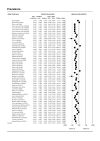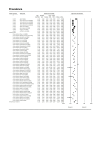A systematic review of Amblyopia prevalence among the children of the world
- PMID: 33367172
- PMCID: PMC7739017
- DOI: 10.22336/rjo.2020.56
A systematic review of Amblyopia prevalence among the children of the world
Abstract
Objective: to assess the prevalence of Amblyopia disease in the children of the world. Methods: In order to perform this systematic review, PICO was considered as the research question. Then, the preferred keywords were searched in Medline (via PubMed), Embase, Scopus, Web of Science, and ProQuest databases. The retrieved citations were reviewed by two independent inspectors in a three-step process in terms of the title, abstract, and full-text, based on the inclusion criteria. The studies included in the review were critically evaluated and then were extracted by two dependent expert reviewers. Finally, the prevalence of Amblyopia disease in the children of the world was pooled by meta-analysis CMA v.2 software. The heterogeneity of the selected studies was evaluated using I2 and chi-square. Also, subgroup-analysis was performed using designs and continents. Results: Out of 952 retrieved citations, 131 studies were included. The total prevalence of Amblyopia in the children of the world was calculated to be 4.3% [Pooled Prevalence: 4.3%, 95% CI: 2.6%-7.00%, P-value 0.0001]. In addition, the heterogeneity of the studies was reported to be high (Q: 48281.18, df: 56, p-value 0.001, I-square: 99.88). The subgroup analysis showed that America had the highest (5.57%, 95% CI: 2.23%-13.94%, P-value 0.0001) prevalence, and the lowest prevalence of Amblyopia in the children of the world was seen in Africa (7.1%, 95% CI: 0.003%-172.53%, P-value 0.05). Conclusion: It can be concluded that the total prevalence of Amblyopia is 3.4%, but this estimate varies in all continents, especially in Africa. The major reason for this variation was reported to be the heterogeneity of studies. These assessments have investigated different populations in terms of severity of illness, age, and gender. Therefore, further worldwide high-quality and valid studies should be carried out to allow the calculation of the real prevalence of Amblyopia among children of the world. Abbreviations: VA = visual acuity, ALSPAC = Avon Longitudinal Study of Parents and Children, JBI = Joanna Briggs Institute, PRISMA = Systematic Review and Meta-analysis, CMA = Comprehensive Meta-analysis Software.
Keywords: Amblyopia; child; meta-analysis; prevalence; systematic review.
©Romanian Society of Ophthalmology.
Figures
Similar articles
-
Global and regional estimates of prevalence of amblyopia: A systematic review and meta-analysis.Strabismus. 2018 Dec;26(4):168-183. doi: 10.1080/09273972.2018.1500618. Epub 2018 Jul 30. Strabismus. 2018. PMID: 30059649
-
Beyond the black stump: rapid reviews of health research issues affecting regional, rural and remote Australia.Med J Aust. 2020 Dec;213 Suppl 11:S3-S32.e1. doi: 10.5694/mja2.50881. Med J Aust. 2020. PMID: 33314144
-
Prevalence of Vancomycin-Resistant Enterococcus (VRE) in Companion Animals: The First Meta-Analysis and Systematic Review.Antibiotics (Basel). 2021 Jan 31;10(2):138. doi: 10.3390/antibiotics10020138. Antibiotics (Basel). 2021. PMID: 33572528 Free PMC article.
-
Association between birth interval and wasting in children under 5 years of age in Ethiopia: a systematic review and meta-analysis protocol.BMJ Open. 2020 Nov 10;10(11):e037976. doi: 10.1136/bmjopen-2020-037976. BMJ Open. 2020. PMID: 33172943 Free PMC article.
-
Global prevalence of amblyopia and disease burden projections through 2040: a systematic review and meta-analysis.Br J Ophthalmol. 2020 Aug;104(8):1164-1170. doi: 10.1136/bjophthalmol-2019-314759. Epub 2019 Nov 8. Br J Ophthalmol. 2020. PMID: 31704700
Cited by
-
Current Developments in the Management of Amblyopia with the Use of Perceptual Learning Techniques.Medicina (Kaunas). 2023 Dec 27;60(1):48. doi: 10.3390/medicina60010048. Medicina (Kaunas). 2023. PMID: 38256309 Free PMC article. Review.
-
Meridional Amblyopia and Spectacle Correction: A Prospective Interventional Study of Children Aged 4-11 Years.Cureus. 2024 Aug 22;16(8):e67549. doi: 10.7759/cureus.67549. eCollection 2024 Aug. Cureus. 2024. PMID: 39310641 Free PMC article.
-
Efficacy of Amblyopia Treatments in Children Up to Seven Years Old: A Systematic Review.Cureus. 2024 Mar 22;16(3):e56705. doi: 10.7759/cureus.56705. eCollection 2024 Mar. Cureus. 2024. PMID: 38650802 Free PMC article. Review.
-
Abnormal effective connectivity in visual cortices underlies stereopsis defects in amblyopia.Neuroimage Clin. 2022;34:103005. doi: 10.1016/j.nicl.2022.103005. Epub 2022 Apr 8. Neuroimage Clin. 2022. PMID: 35421811 Free PMC article.
-
Rehabilitation of amblyopia using a digital platform for visual training combined with patching in children: a prospective study.Graefes Arch Clin Exp Ophthalmol. 2024 Sep;262(9):3007-3020. doi: 10.1007/s00417-024-06475-0. Epub 2024 Apr 5. Graefes Arch Clin Exp Ophthalmol. 2024. PMID: 38578335 Free PMC article.
References
-
- Gerali PS, Flom MC, Raab EL. Report of the Children's Vision Screening Task Force: National Society to Prevent Blindness. National Society to Prevent Blindness. 1990
-
- Hong CL, Press LJ. Visual factors in childhood behavioral disorders. California Optometry. 2009;36(4):46–54.
-
- Gunnlaugsdottir E, Arnarsson A, Jonasson F. Prevalence and causes of visual impairment and blindness in Icelanders aged 50 years and older: the Reykjavik Eye Study. Acta Ophthalmol. 2008 Nov;86(7):778–785. doi: 10.1111/j.1755-3768.2008.01191.x. - PubMed
-
- Pai AS-I, Wang JJ, Samarawickrama C, Burlutsky G, Rose KA, Varma R, Wong TY, Mitchell P. Prevalence and risk factors for visual impairment in preschool children: the Sydney Paediatric Eye Disease Study. Ophthalmol. 2011 Aug;118(8):1495–1500. doi: 10.1016/j.ophtha.2011.01.027. - PubMed
Publication types
MeSH terms
LinkOut - more resources
Full Text Sources
Medical
Miscellaneous




